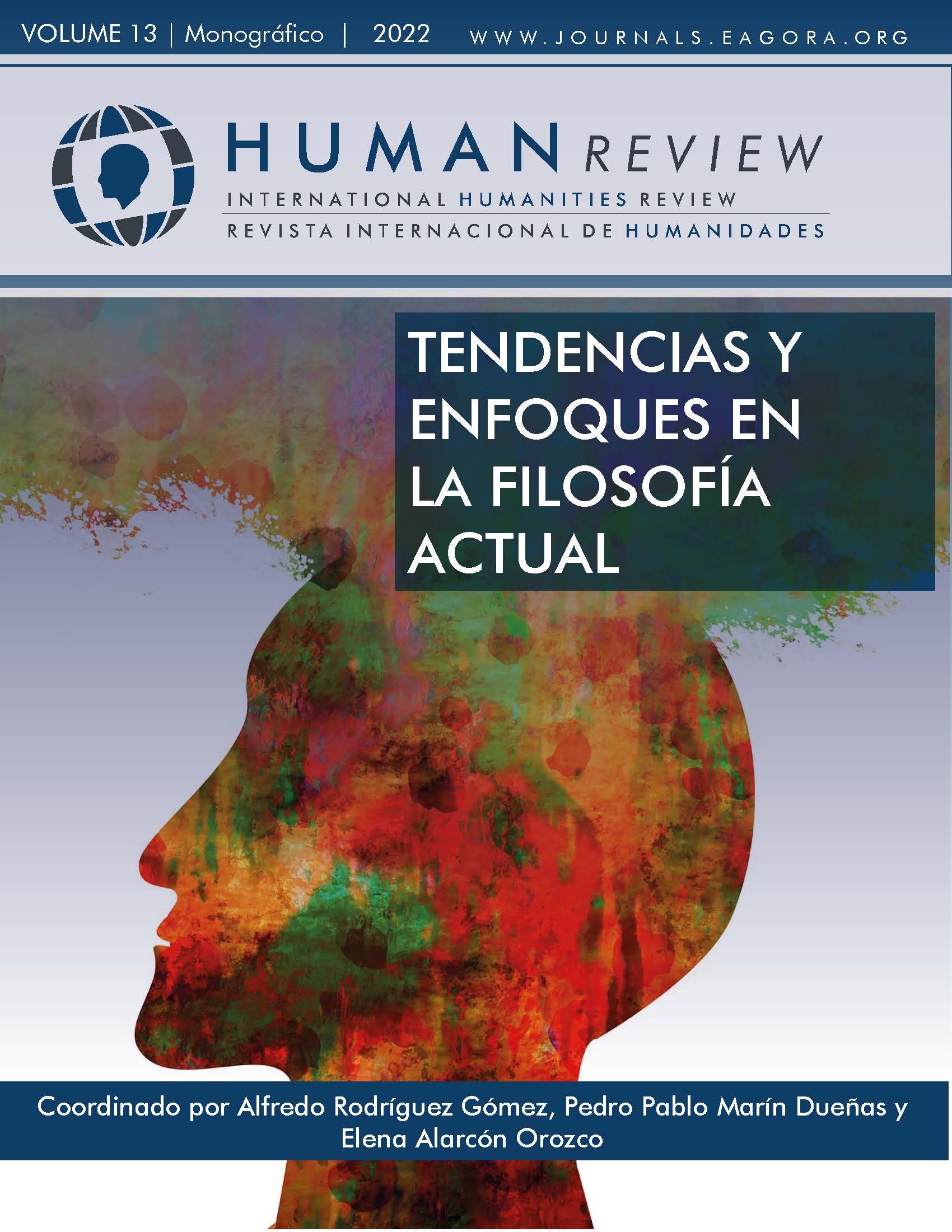Nexos entre tecnología y filosofía: el caso específico del ecosistema del metaverso
Categorización filosófica de términos tecnólogicos desde la Suma Teológica de Santo Tomás
DOI:
https://doi.org/10.37467/revhuman.v11.4070Palabras clave:
Sociedad Digital, Metaverso, Humanidades Digitales, Filosofía de la tecnología, Tomismo, Inteligencia ArtificialResumen
El desarrollo de la tecnología y de la inteligencia artificial provocan desde hace años preguntas éticas y antropológicas. La Suma Teológica de Santo Tomás permite categorizar términos tecnológicos y establecer ontologías en clave filosófica. Con esta metodología de la Suma se va a estudiar aquí el término “metaverso” y sus implicaciones éticas. El artículo aporta además una revisión sistemática de literatura científica para elaborar un mapa de conocimiento desde un punto de vista cualitativo y cuantitativo que visibilice el impacto de esta terminología emergente en la investigación.
Citas
Agejas, J.A. (2020). Seréis como dioses. Thibón, Gustave. Relectiones, 7, 139-141.
Alzheimer’s Research UK (2020). A Walk Through Dementia. http://www.awalkthroughdementia.org
Ayiter, E. (2019). Spatial poetics, place, non-place and storyworlds: intimate spaces for metaverse avatars. Technoetic Arts, 17 (1-2) 155-169.
Barraca Mairal, J. (2021). Humanismo digital y uso prudente de las TICS en lo inter-personal. Human Review, international Humanities Review, 10 (1) 87-97 a. https://journals.gkacademics.com/revHUMAN/article/view/3111/1778
Bolger, R.K. (2021). Finding Wholes in the Metaverse: Posthuman Mystics as Agents of Evolutionary contextualization. Religions, 12 (768).
Campbell, J. (2015). El héroe de las mil caras: Psicoanálisis del mito. Fondo de Cultura.
Cheek, J. (2021). Big data, Thick Data, Digital Transformation, and the Fourth Industrial Revolution: Why Qualitative Inquiry is more Relevant than Ever. Routledge.
Cornerstone. (2020). Cornerstone VR Programme Case Studies. April 2020. https://v.fastcdn.co/u/2d109d62/50664650-0-5.-Case-studies---Co.pdf
Engelhardt, H.T. (1995). Los fundamentos de la bioética. Paidos.
Kim, W. C., & Mauborgne, R. A. (2015). Blue Ocean Strategy, Expanded Edition: How to Create Uncontested Market Space and Make the Competition Irrelevant.
Lawtoo, N. (2021). Black Mirrors: Reflecting (on) Hypermimesis. Philosophy Today, 65 (3) 523-547.
https://www.pdcnet.org/philtoday/content/philtoday_2021_0065_0003_0523_0547
Lin, Y., Shejiao, D. (2019). Ethics and risks between human and robotic interaction. Interaction Studies, (20) 1 134-147.https://www.jbe-platform.com/content/journals/10.1075/is.18009.yu
Lisberger, S. (1982). Tron. Película.
anna, R., Rajakishore, N. (2021). Kantian Moral Agency and the Ethics of Artificial Intelligence. Problemos. Vol. 100, 139-151.
Madary, M., Metzingier, T.K. (2016). Real virtuality: A code of ethical conduct, recommendations for good scientific practice and the consumers of VR-technology. Frontiers in Robotics and AI.
Morte Ferrer, R. (2021). Valoraciones éticas para una inteligencia artificial adecuada a la privacidad. ARBOR: Ciencia, pensamiento y cultura. Vol. 197-802.
Munk, A., Olesen, A., Jacomy, M. (2022). The Thick Machine: Anthropological AI between explanation and explication. Big Data and society, 9 (1).
Murray, J. (2020). Virtual / reality: How to Tell the Difference. Journal of Visual Culture, 19 (1) 11-27.
https://journals.sagepub.com/doi/pdf/10.1177/1470412920906253
Neiman, N. R., Falkson, S. R., Rodriguez, S. T., Wang, E. Y., Hemphill, S. F., Khoury, M. E., Kist, M. N., Jackson, C. D., & Caruso, T. J. (2022). Quantifying virtual reality pain modulation in healthy volunteers: A randomized, crossover study. Journal of Clinical Anesthesia, 80, 110876. https://doi.org/10.1016/j.jclinane.2022.110876
Pastor, J. (2022, mayo 3). Meta prepara cuatro gafas de realidad virtual y aumentada: Serán mejores pero también más caras que las Quest 2. Xataka. https://bit.ly/3ReIgj6
Rospigliosi, P. (2022). Metaverse or Simulacra? Roblox, Minecraft, Meta and the turn to virtual reality for education, socialisation and work. Interactive learning Environments, 30 (1) 1-3.
https://www.tandfonline.com/doi/full/10.1080/10494820.2022.2022899
Stephenson, N. (1992). Snow Crash. Bantam Books.
Stephenson, N. (2011). Snow Crash. Penguin.
Tillería Aqueveque, L. (2022). Transhumanismo e inteligencia artificial: el problema de un límite ontológico. Griot, Revista de Filosofía, 22 (1) 59-67. https://www.redalyc.org/articulo.oa?id=576670028006
Turner, V. (2016) Liminality and Communitas. https://bit.ly/3SafssT
Urquhart, L., Reedman-Flint, D., Leesakul, N. (2019). Responsible domestic robotics exploring ethical implications of robots in home. Journal of Information Communication & Ethics in Society. (17) 2 246-272.
Vaccari, A. (2014). La posthumanidad como un bien objetivo: los peligros del futurismo en el debate sobre la optimización genética humana. Acta Bioethica, 20 (2) 237-245.
Valera, S., Valdés, P., Viñas, S. (2021). NFT and digital art: new possibilities for the consumption, dissemination and preservation of contemporary works of art. Artnodes, 21.
Wang, F., Qin, R., Wang, X. (2022). MetaSocieties in Metaverse: MetaEconomics and MetaManagement for MetaEnterprises and MetaCities. IEEE Transactions on Computational Social Systems. 9 (1) 2-7.
Referencias de obras clásicas:
De Aquino, S. Tomás (2001). Suma Teológica. Biblioteca de Autores Cristianos.
Descargas
Publicado
Cómo citar
Número
Sección
Licencia
Aquellos autores/as que publiquen con esta revista, aceptan los términos siguientes:
- Los autores/as conservarán los derechos morales sobre la obra y cederán a la revista los derechos comerciales.
- Transcurrido 1 año desde su publicación, la versión del editor pasará a estar en acceso abierto en la web de la editorial, pero la revista mantendrá el copyright de la obra.
- En el caso de que los autores deseen asignar una licencia abierta Creative Commons (CC), podrán solicitarla escribiendo a publishing@eagora.org.








